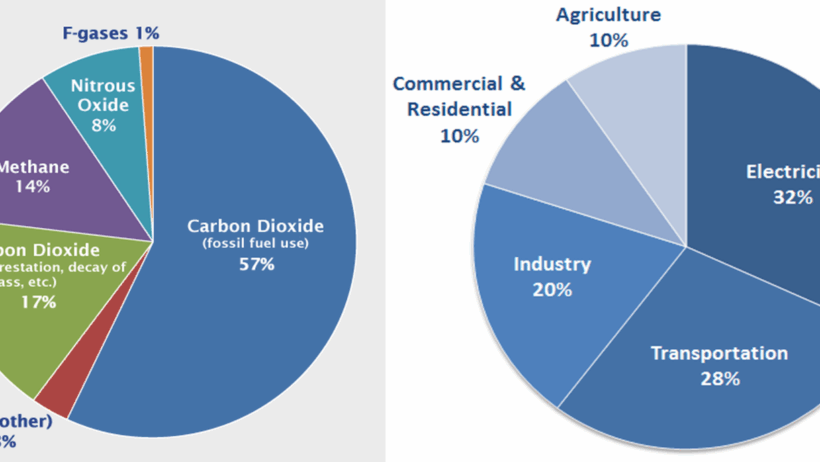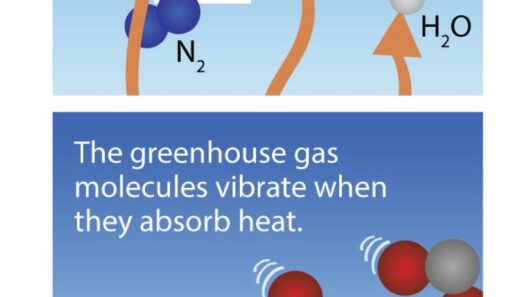The planet we inhabit is ensconced in a delicate veil of gases, each playing a pivotal role in maintaining the equilibrium essential for life. Among these, a small cadre of gases holds paramount importance in regulating Earth’s temperature. This article embarks on an exploration of the gases that contribute most significantly to the greenhouse effect, asserting their dominance and intricate interrelations in the climate system.
As the sun’s rays penetrate the atmosphere, they warm the Earth’s surface, much like a gentle embrace. However, the warmth must be balanced with an equal measure of cooling, a task primarily assigned to greenhouse gases. Think of them not just as culprits in climate change, but as a complex orchestra where each gas plays a unique instrument to produce the symphony of atmospheric dynamics.
In this orchestration, carbon dioxide, methane, and nitrous oxide emerge as the principal players, with carbon dioxide taking the lead. Understanding how these gases function and interact is vital for unraveling the narrative of climate change.
Carbon Dioxide: The Silent Protagonist
Carbon dioxide (CO2) is often touted as the quintessential greenhouse gas, and for good reason. It accounts for a staggering percentage of the total greenhouse gas emissions attributable to human activity. This gas sees its origins in various anthropogenic processes—predominantly the burning of fossil fuels such as coal, oil, and natural gas.
When fossil fuels combust, they release carbon dioxide, which then mingles with other atmospheric constituents like a guest at an unwelcome party. Its molecular structure allows it to absorb infrared radiation emitted from the Earth’s surface, which effectively traps heat and contributes to global warming. The persistence of CO2 in the atmosphere—lasting hundreds of years—serves to amplify its impact, creating an enduring effect on climate patterns.
While it is easy to conflate the abundance of carbon dioxide with its potency, the reality is that its effectiveness as a greenhouse gas is not solely dictated by its volume. Instead, its unique ability to absorb various wavelengths of infrared radiation enables it to exert a profound influence on global temperatures.
Methane: The Potent Forgotten
If carbon dioxide is the orchestra’s woodwind section, then methane (CH4) plays a vital role akin to the brass—powerful yet often overlooked. Methane may not be as abundant as carbon dioxide, but its efficacy in trapping heat is prodigious. In fact, methane is approximately 25 times more effective at heat retention over a 100-year period than CO2, a statistic that underscores its capacity to amplify climatic changes.
The sources of methane are diverse, ranging from natural origins like wetlands, to human-induced emissions from livestock, coal mining, and landfills. The total global warming potential of methane, while significant, is further exacerbated by its relatively short atmospheric lifespan—around a decade before it oxidizes into carbon dioxide. This short-lived yet intense burst of heat contributes to climate change in a manner that is both immediate and insidious.
To consider methane solely from an individual standpoint is to miss the broader orchestral harmony. Its potency is enhanced further by the presence of other pollutants, like black carbon and ozone, creating a nuanced dialogue in climatic changes that defies simplistic analysis.
Nitrous Oxide: The Understated Player
Nitrous oxide (N2O), while lesser-known, plays a crucial role in the greenhouse gas ensemble. Emissions of N2O stem significantly from agricultural practices, particularly the application of synthetic fertilizers, as well as soil cultivation. This gas boasts a global warming potential that is about 298 times greater than that of carbon dioxide on a per-molecule basis—a staggering statistic that reveals its capacity to influence temperature trends.
While nitrous oxide constitutes a smaller proportion of overall greenhouse gas emissions, its cumulative effects illustrate how vital it is to the climate narrative. The gas lingers in the atmosphere for approximately 114 years before it breaks down, thereby necessitating vigilance in agricultural and industrial practices to mitigate its release.
Understanding the interplay between these greenhouse gases unveils the need for a holistic approach to combating climate change. Each gas dances in tandem with others—amplifying or counterbalancing effects—that ultimately shape the future of our planet.
Mitigating Greenhouse Gas Emissions: Strategies for Change
To engage meaningfully with the climate crisis, it is imperative to advocate for effective emission reduction strategies targeting each greenhouse gas with precision. Transitioning to renewable energy sources, enhancing energy efficiency, and adopting sustainable agricultural practices can collectively reduce the reliance on fossil fuels and cut down emissions significantly.
The burgeoning field of carbon capture technology offers another avenue for mitigating carbon dioxide emissions, while programs aimed at reducing food waste can curtail methane and nitrous oxide releases. By leveraging innovative solutions and fostering a culture of sustainability, humanity can begin to rewrite the script currently dictated by these dominant greenhouse gases.
Conclusion: Charting a Path Forward
The myth of invincibility over climate change can no longer hold sway. Carbon dioxide, methane, and nitrous oxide stand as pivotal players, significantly influencing the tapestry of Earth’s climatic system. To truly grasp their role is to recognize that confronting climate change requires a metamorphosis of both thought and action.
Let us not view greenhouse gases in isolation but rather as integral threads in the fabric of our planet’s future. Building bridges between science, technology, and policy can fortify our efforts to mitigate their impacts, ensuring a balanced and thriving Earth for generations to come.






